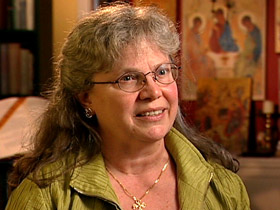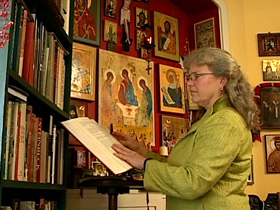Frederica Mathewes-Green Extended Interview
Read more of Kim Lawton’s interview about the Star of Bethlehem with Frederica Mathewes-Green:
Q: What is it about the Star of Bethlehem, this character in the Christmas story?
A: I would really hate for the focus on uncovering what this was historically or scientifically or astronomically to eclipse the fact that this is a star of wonder. The intense sense of wonder that surrounds this whole story — I know when I was a child and would be hearing the Christmas story, so much of it seemed homey and familiar. There’s the sheep. There’s the manger. But then when there was this exotic element where you have these three wise men — what in the world is that when you’re a kid? Coming in on camels and they’re dressed like kings, and they’re following the star. The star that’s at the center of that part of the story is such an object of wonder because we don’t understand what it is. And it brings an injection of something into the story that isn’t familiar, because these are people who are not children of Israel. These are people who are coming from the East, and what I found the church fathers said is that they were in the same tradition as Baalam, the prophet at the time of Moses who prophesied that a star would arise out of Jacob. In the early writings of the church, you found people playing with that and saying these wise men had been taught by generations of prophets to look for this star. So when they saw it, they knew what it was, and what it means as well is this is the first time we have non-Jews participating in the worship of Jesus. So, you know, that was a big debate in the early church about whether you had to be Jewish in order to be a Christian, and right at the beginning of the story we see this in-breaking, so it’s a wonderful moment of inclusiveness that the star brings to us.

Q: And part of that is a revelation, too, revealing elements of the story.
A: Yes, it’s wonderful to see that people even who were not in the Judeo-Christian tradition still could have revelation, could have that little prophecy that they knew was important and [they] clung to it, and that they kept looking for that star. The people of that religion honored light as symbolic of God. They believed in one God, and they believed that he was represented by fire or starlight or sunlight, but it was light, and Christians can identify with that. We know that God is light. We forget that before a hundred years ago there was no experience of light that was not also an experience of fire. So this combination of the fire of light, the fire of the stars — it brings a vitality to it, I think, compared to how we think of light these days. So the wise men, the magi following that star, following the light till they reached the light, the light of Christ, is a very beautiful kind of metaphor that is much more than a metaphor at the heart of scripture and at the beginning of the Christmas story.
Q: For Christians, Christmas is a time that celebrates God coming down to earth through Jesus in human form. How does the star play into that part of the Christmas story?
A: One of the nice things about the star being part of the story is that, in a way, it’s not spiritual. It is something that is solid and real and material. Stars are a real thing that exists in the universe, and even if you disagree about what form that star took — for example, Saint John Chrysostom said it wasn’t a star at all, a star can’t point out a particular house, it was an angel. It was something that had been transformed into the likeness of a star that could nevertheless lead them and come to rest right over the house where Jesus was. No matter what we make of it, we can acknowledge that it is something that existed in this real world. And I get frustrated with people who say, “Well, the star was just a myth,” because if you’ve already accepted the idea of the incarnation, then you’ve swallowed the camel and you’re straining out the gnat. The incarnation of God into human form is a much bigger miracle than just God controlling a star, or something that appeared to be a star. So what all this is about is the presence of God working through material reality. Christians have always insisted on that against the idea that God exists in some separate realm and doesn’t exist in the form of matter or muddle in matter at all. We see that he is present here now. Really, that’s what the incarnation is all about.

Q: Year after year people hear the same story, and there does seem to be eternal, enduring interest in all parts of it.
A: I think that this story speaks to something deeply buried in human nature that has to do with the whole mystery of our existence. As the book of Ecclesiastes says, “God has put eternity in our minds.” How can we have eternity in our minds? The mystery of that keeps calling us forward. Somehow when we come to this story of a poor woman giving birth in a stable and of a star pointing out that child and bringing men from the East, wise men, this collision of the simple and the humble with the most elevated and mysterious, we know that there’s something true there, even if we’re not yet able to claim the entire story. We sense that there’s some kind of truth in that story that pulls us forward. They always want to know more.
Q: Some people have also talked about the star’s element of guidance or leading — a means by which God guided people.
A: The star was a means of guidance. It replicates the story of the children of Israel in the wilderness with Moses, being led by, it says, a cloud by day and a pillar of fire by night. What led the wise men is very similar to that pillar of fire, and we should not be surprised that God is able to use material reality, things like stars, to lead his people. I think the greater miracle is that he can use me, you know? That he can guide me and direct me. Stars are a lot easier to direct than something as hard-headed as I am. But the more I welcome his direction into my life, the more I know that joy of participating fully in the dance of the cosmos that our God orchestrates every day.
Q: Does the Christmas story still have the same power, the same newness and appeal, every year?
A: The Christmas story has such power and such appeal every year. There are other stories we get tired of. You think of your favorite movie; you don’t want to watch it 15 times. I’m 55. I’ve heard this Christmas story year after year after year. There is a mystery in the heart of it that never fails to tantalize us, which will tell that there’s something more there, and the closer we get to it, the more the mystery and the depth unfold. I think that’s one of the things that the star speaks to us, that in its brilliance, its luminosity, its elevated qualities it participates in this very same universe that we’re in, that it shows us the depths of the story and, just as it led the wise men, it leads us as well deeper and deeper into the mystery.

